传播学概论 英文版课件
- 格式:pps
- 大小:509.00 KB
- 文档页数:26
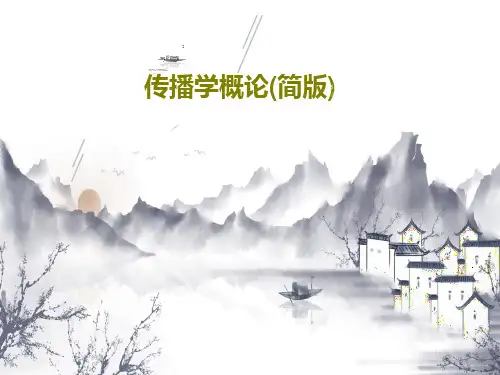
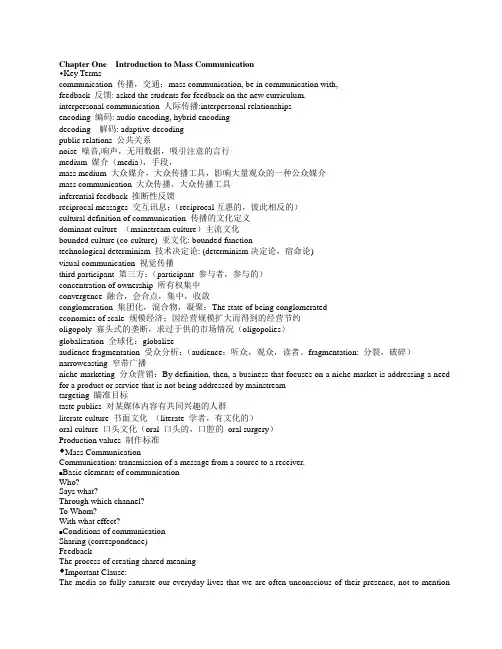
Chapter One Introduction to Mass Communication♦Key Termscommunication 传播,交通:mass communication, be in communication with,feedback 反馈: asked the students for feedback on the new curriculum.interpersonal communication 人际传播:interpersonal relationshipsencoding 编码: audio encoding, hybrid encodingdecoding 解码: adaptive decodingpublic relations 公共关系noise 噪音,响声,无用数据,吸引注意的言行medium 媒介(media),手段,mass medium 大众媒介,大众传播工具,影响大量观众的一种公众媒介mass communication 大众传播,大众传播工具inferential feedback 推断性反馈reciprocal messages 交互讯息:(reciprocal互惠的,彼此相反的)cultural definition of communication 传播的文化定义dominant culture (mainstream culture)主流文化bounded culture (co-culture) 亚文化: bounded functiontechnological determinism 技术决定论: (determinism决定论,宿命论)visual communication 视觉传播third participant 第三方:(participant 参与者,参与的)concentration of ownership 所有权集中convergence 融合,会合点,集中,收敛conglomeration 集团化,混合物,凝聚:The state of being conglomeratedeconomies of scale 规模经济;因经营规模扩大而得到的经营节约oligopoly 寡头式的垄断,求过于供的市场情况(oligopolies)globalization 全球化:globalizeaudience fragmentation 受众分析:(audience:听众,观众,读者。
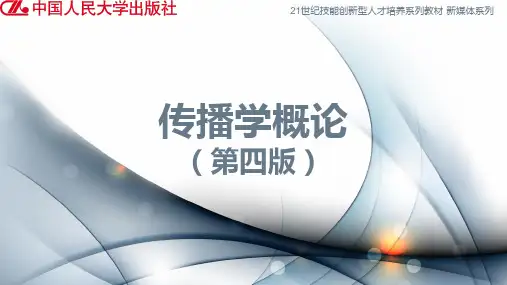
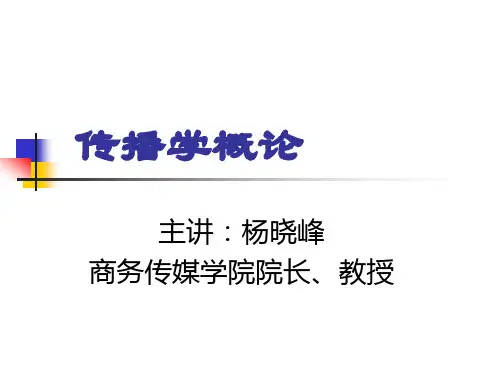

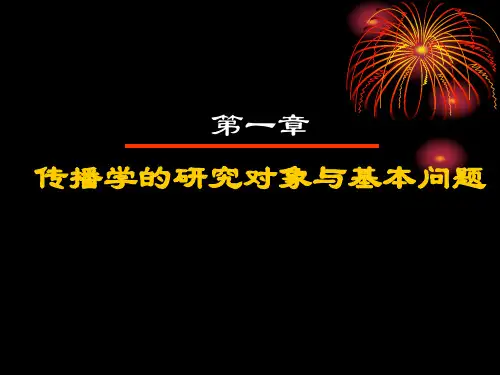

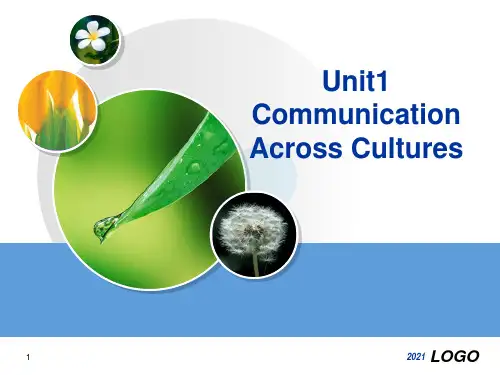


传播学经典理论英文版[中文批注]目录一、Opinion Leaders 意见领袖 __________________________________________ 2 ____二、5W Box 5w 理论__________________________________________________ _ ______三、The Bias of Communication 传媒偏向论_________________________________ 2四、The Spiral of Silenee 沉默的螺旋_____________________________________ 3五、Gatekeeper把关人理论_____________________________________________ 4 ____六、Selective exposure hypothesis 选择性接触假说____________________________ 4七、Knowledge Gap Theory 知识沟假说____________________________________ 5八、Agenda Setting Theory 议程设置理论___________________________________ 5九、Magic bullet theory 魔弹论 ____________________________________________ 5 ____十、Information (Innovation ) Diffusion Theory 信息(创新)扩散论____________________ 6十^一、Uses a nd gratificati ons theory (UGT)使用与满足理论 ______________________ 7十二、Cultivation theory 教养理论___________________________________________ 8十三、Limited-Effects Theory 有限效果论 ______________________________________ 8十四、Marshall Mcluhan Media Theory麦克卢汉的媒介理论________________________ 92/ 11一、Opinion Leaders 意见领袖Active in information networks, have many information channels ,so they can often provi de in formati on and advice for others and can in flue nee others.意见领袖是指在人际传播网络中经常为他人提供信息,同时对他人施加影响的“活跃分子”,他们在大众传播效果的形成过程中起着重要的中介或过滤的作用,由他们将信息扩散给受众,形成信息传递的两级传播。
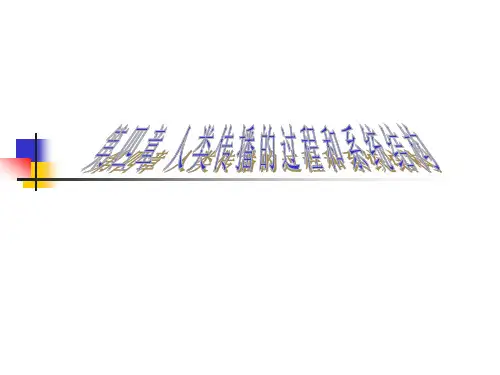
传播学经典理论英文版[中文批注]目录一、Opinion Leaders 意见领袖_________________________________________________ 2二、5W Box 5w 理论__________________________________________________________ 2三、The Bias of Communication 传媒偏向论 _____________________________________ 2四、The Spiral of Silence 沉默的螺旋 ___________________________________________ 3五、Gatekeeper 把关人理论 ___________________________________________________ 4六、Selective exposure hypothesis 选择性接触假说_________________________________ 4七、Knowledge Gap Theory 知识沟假说_________________________________________ 5八、Agenda Setting Theory 议程设置理论 _______________________________________ 5九、Magic bullet theory 魔弹论_________________________________________________ 5十、Information ( Innovation ) Diffusion Theory 信息(创新)扩散论 _________________ 6十一、Uses and gratifications theory (UGT) 使用与满足理论__________________________ 7十二、Cultivation theory 教养理论_________________________________________________ 8十三、Limited-Effects Theory 有限效果论__________________________________________ 8十四、Marshall Mcluhan Media Theory 麦克卢汉的媒介理论____________________________ 92 / 11一、Opinion Leaders 意见领袖Active in information networks, have many information channels ,so they can often provide information and advice for others and can influence others. 意见领袖是指在人际传播网络中经常为他人提供信息,同时对他人施加影响的“活跃分子” ,他们在大众传播效果的形成过程中起着重要的中介或过滤的作用,由他们将信息扩散给受众,形成信息传递的两级传播。
CommunicationAn IntroductionWhat is communication?☐The process of sending and receiving messages and is both verbal and nonverbal (Fujishin)☐“a process by which information is exchanged between individuals through a common system of symbols, signs, or behavior” (Webster’s Dictionary)☐the process of acting on information; it is a transactive process where messages are sent and received simultaneously; It is the way in which we make sense out of the world in which we live (Beebe & Masterson)Linear model of communication process☐Generalizing communicationprocess☐Providing differentviewpoints from which toinvestigate masscommunication☐Implying the presence of acommunicator and apurposive message(Lasswell,1948)Linear model of communication process InformationSource Transmitter ReceiverDestination NoiseSourceMessageSignal Received Signal Message (Shannon and Weaver 1949)· With engineering and mathematical background· Seeing communication as the transmission of messages· Noticing the important factor “noise” in the process of communicationNetwork Communication ModelEncoder InterpreterDecoderDecoderInterpreterEncoder MessageMessage(Schramm 1954)•Realizing differences between the intention of sender and the reception of receiver.•Seeing feedback and the continuous “loop” of shared information.Levels of communication☐Intra-personal communication ☐Inter-personal communication ☐Group communication☐Organizational communication ☐Mass communicationDefining mass communicationMass communication is a process in which professional communicators design and usemedia to disseminate messages widely, rapidly,and continuously in order to arouse intendedmeanings in large, diverse, and selectivelyattending audiences in attempts to influence them in a variety of ways.(DeFleur and Dennis)Communication research methods☐Qualitative research methods(e.g. focus group, field observation,intensive interviews, and case study)☐Quantitative research methods(e.g. survey research, content analysis,experimental design)Internet sourcewww.wimmerdominick .comQualitative research methods☐Focus group: an interviewconducted with 6-12 subjectssimultaneously and a moderatorwho leads a discussion about aspecific topic.☐Field observation: a study of aphenomenon in a natural settingQualitative research methods☐Intensive interview: theone-on-one personalinterview.☐Case study: a study that uses multiple sources of data to examine many characteristics of a single subject (e.g., a newspaper, a television station, ad agency)Quantitative Research methods☐Survey research: the study of a portion or sample ofa specific “population”(e.g. magazine subscribers,newspaper readers, television viewers) by using thetechnique of questionnaires.☐CATI:computer-assistanttelephone interviewing; videodisplay terminals are used byinterviewers to presentquestions and enter responsesQuantitative Research methods☐Content analysis: a systematicmethod of analyzing messagecontent.☐Experimental design: the classic method of dealing with questions of causality. An experiment involves the control or manipulation of a variable by theexperimenter and an observation or measurement of the result in an objective and systematic way.Chapter 1Research as a Basisfor Understanding Mass CommunicationSelection criteria for the milestones☐Some combination of multiple criteria⏹Historical⏹Theoretical⏹Methodological⏹Overall scope☐Historical context☐SponsorshipMass Society Theory☐Mass society is not indicated by the number of people but refers to the industrial, urban andmodern society, which is distinctively different from the traditional society in terms ofrelationships among its members.☐To understand the concept of mass society, we need to look at the traditional society.The Traditional Society☐Dominated by agricultural production, with people rooted to the land;☐Self-sufficient, people produce for own use;☐Individual artisans and craftsmen were complete producers, responsible for buyingmaterials, producing and selling the products.Each person was doing the work of severalcompanies today.The Traditional Society☐Human relationships were marked by strong ties of the family, kinship and loyalty to localrulers, or deeply established beliefs, customsand traditions.☐Communication was a matter of word-of-mouth.Books were printed but were for the elite.The Master Trends☐By end of 18th Century, major changes taking place in traditional society. Three trends…⏹Industrialization⏹Urbanization⏹Modernization☐Each had profound influence on…⏹social relationships⏹material culture⏹social norms, and⏹Thought ways of individualsContemporary Society as “Mass Society”☐“Mass society” emerges when the following takes place… (see Lowery p. 11-12)⏹1) Social differentiation in the society increases.⏹2) Effectiveness of informal social controlserodes as traditional norms and values decline⏹3) The use of formal social controls increases.⏹4) Conflicts increase because of socialdifferences between people .⏹5) Open and easy communication becomes moredifficult.⏹6) Because of these, people become moredependent on mass communication forinformation.Audio: How you gonna keep’ em down on the farm after they've seen Paree?☐This song was written by JoeYoung and Sam M. Lewis withmusic by Walter Donaldson, andwas published in 1918.☐It reflected that the moral norms ofthe traditional American way of lifeseemed to be deteriorating, beingplaced by looser and looserstandards after the World War I.Click here to listento this songThe magic bullet theorySuch a theory assumes:☐People live isolated lives.☐People are endowed with a uniform set of instincts.☐People attend to media messages in similar ways.☐They receive and interpret messages in the same way.☐Thus, messages are like bullets, striking everyone with the immediate,uniform, and powerful effect.Industrialization☐The incorporation of people into work organisations;☐People come into contact with more people on an anonymous basis;☐Increased use of formal social controls (contracts, laws, etc.);☐Impersonal relationship dominates humanrelationships;☐Bureaucracy as a form of social organisation in whicha hierarchy of position is developed, with power,authority and responsibility clearly defined.ExitUrbanization☐An increasing proportion of the population of a given area live in towns and cities;☐Unlike people live and work together, which result in a confusion of the rules, customs, and tradition (anomie);☐The contract rather than the handshakebecomes the principal basis of regulatingobligations between people.ExitModernization☐Modernization brings about more technologies and innovations to generate and meet societalneeds;☐Material lifestyles , based on consumption of the products of the new industries, were quite different at each level in the stratification system.☐The process of modernization is closely linked with the growth of the mass media. Modern societies,then are media-dependent societies.ExitVariable☐Variable: a phenomenon or event that can be measured or manipulated.☐Independent variable: it is thought to influence changing another variable.☐Dependent variable: it is thought to be changed by another variable.☐E.g. Smoking cigarettes causes cancer.ExitMilestones☐The term “milestone” derived from the stone markers place along ancient roads to inform travelers of how far they hadcome and thus how far they had yet to go to reach their eventual goal.☐The 14 milestones featured here provided the reader with a scholarly roadmap of the path taken by mass communicationresearch.Exit。